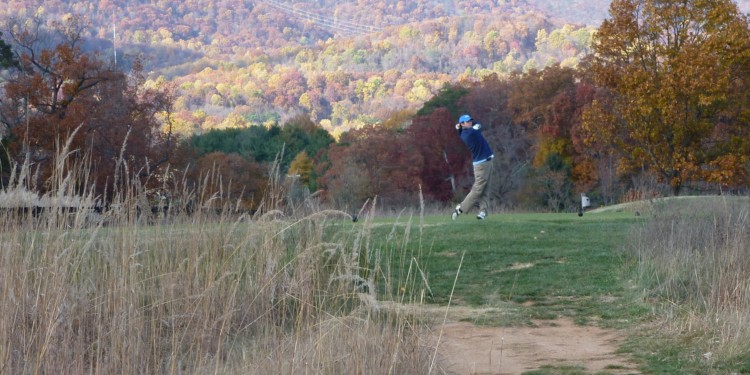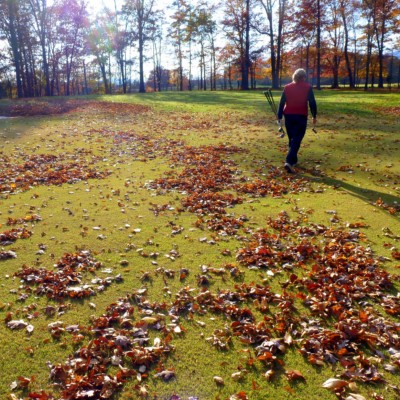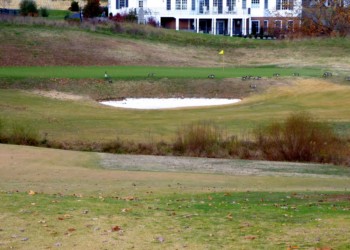
Teeing off on no. 8 at Old Trail, with the Blue Ridge in the background.
If someone were reviewing me, I certainly wouldn’t want him to see me as I am early on some misbegotten Sunday mornings—rumpled and bleary-eyed, dressed in a ratty bathrobe, buried in the newspaper and grumpy until the second cup of coffee kicks in.
So I am a bit reluctant to judge Old Trail Golf Club in Crozet, Virginia after playing it on a chilly, windy, November day, not long after the greens had been aerated. The fairways are brown in November, as they should be, because the course uses a strain of grass that goes dormant in late autumn and doesn’t green up again till late spring. And no course looks its best with brown fairways.
But there’s no avoiding my opinion. Old Trail spoiled a perfectly good pasture.

Looking for a ball amid fallen leaves on Old Trail's 11th.
The course opened about six years ago on a piece of erstwhile farm land, just as the double whammy of recession and overbuilding was about to sock the golf industry. So it’s perhaps not surprising that Old Trail bears the marks of an inadequate maintenance effort. The tees are pockmarked with dirt spots. Golf carts have worn rutted paths where grass ought to be. The bunkers have an odd mix of sands that give them the look of a Starbucks latte—white with patches of brown. The golf course was designed to look a little ragged, with low-lying wet areas left naturally unkempt. Neglect has turned ragged into scruffy.
And only neglect can account for some of what I encountered. There were no red tee markers on the par-three second hole. Someone must have forgotten to put them down. So the female member of my foursome just skipped that hole. A particularly scrofulous flock of Canada geese has apparently taken up residence on the 10th green. The 11th and 12th holes are cut through a wooded portion of the property, but the maintenance staff apparently can’t cope with the falling leaves. Leaves covered so much of the 11th fairway that it was hard to see grass. My group lost three golf balls. Someone wanted a drink of water on the 14th tee. The canister had no cups. And so it went.
Then there’s the course itself. Several holes struck me as ill-conceived. On the par-four fifth, the tee shot has to clear a scraggly patch of trees to hit the main section of the fairway. Play away from the trees and you’re in a pond. Two of the par threes, No. 7 and No. 14, are just stuck on flat, almost featureless patches of ground. They’re as interesting as your old high school classmate who went to work for the phone company.

Geese peck at Old Trail's 10th green.
Old Trail has one beautiful feature in the autumn, and that is the slopes of the Blue Ridge, which rise to the west. They’re red and yellow when the leaves turn. But if you appreciate the Blue Ridge, it’s hard to be happy about Old Trail’s existence.
The course was conceived as part of an enormous real estate development in what once was the rural hamlet of Crozet, about 15 miles west of Charlottesville. Crozet used to be known primarily for a plant that made TV dinners. Then it was the headquarters of the Dave Mathews Band. But Charlottesville is an attractive town, too much so for its own good. Housing prices near the University of Virginia rose beyond the means of professors and university staff. Charlottesville sprawled, north toward Ruckersville and west toward Crozet.
Old Trail is a sprawl engine, the centerpiece of what seems to be an endless chain of houses and townhouses. Soon, it seems, the Blue Ridge itself will be engulfed. And the quality of life that attracted people to the Charlottesville area in the first place will be extinguished by traffic, strip malls and condos. Old Trail is part of that process.
The worst thing is it’s too late to start over. Once the golf course and the condos go in, the farms never come back.
On the bright side, Old Trail is inexpensive. I only paid $29, which is the winter twilight rate. But you get what you pay for.



